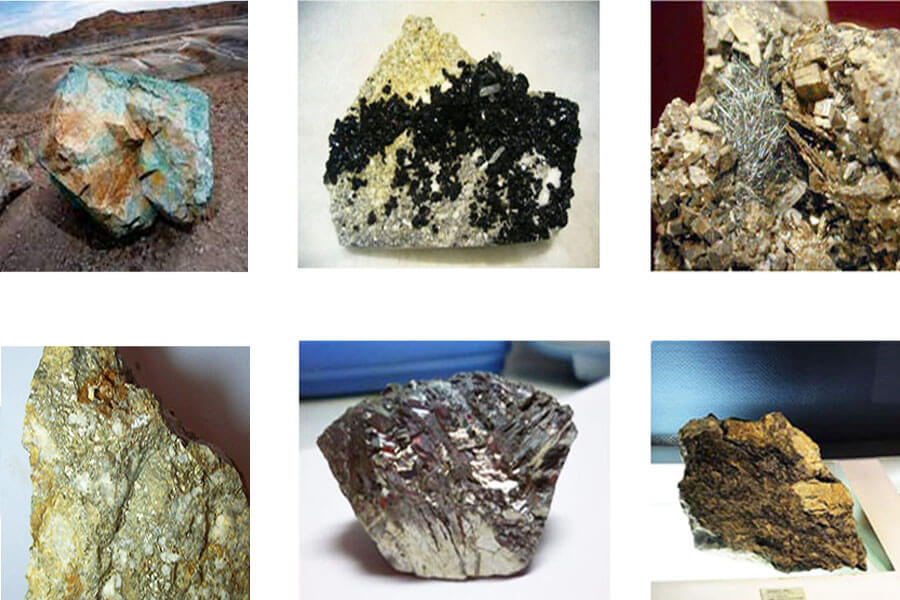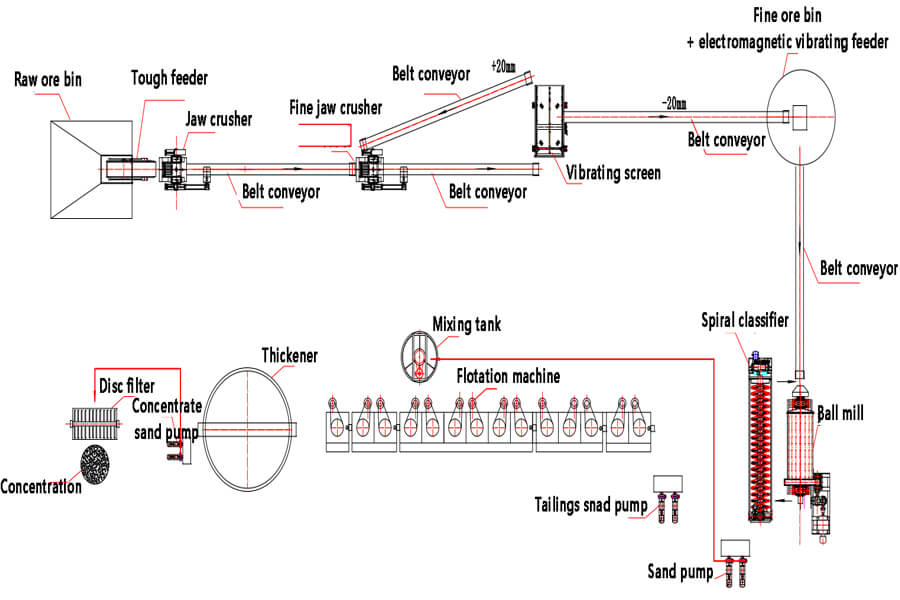- Home
- Blog
- Mineral Solution
- Sulfide Ore Beneficiation Solution
- jxsc
Mining has always been an integral part of human industry. Today, modern mining processes rely heavily on advanced technology to extract valuable minerals from ore. Sulfide minerals common in many parts of the world, such as copper sulfide, gold, lead, zinc and nickel. Sulfide ores contain high concentrations of sulfur-containing minerals and metals that are critical for a wide range of industrial applications. Sulfide ore beneficiation involves refining minerals with sulfur-containing compounds such as sulfides and sulfates, separating them into their elemental components. This type of process has been used for centuries, but technological advancements have increased its effectiveness and efficiency over time. Mineral beneficiation has traditionally been done manually through manual labor-intensive processes such as crushing and grinding ore. However, modern more efficient techniques such as leaching or flotation are used to help speed up the separation between elements. This is a complex and specialized process that requires specialized equipment and knowledge.
What are sulfide minerals
In nature, sulfur is a non-metallic element with a wide distribution and strong affinity. It exists in various forms such as natural sulfur, hydrogen sulfide, metal sulfide and sulfate.
Main features: Most have metallic luster, deep color and streaks, low hardness, high specific gravity, and good thermal conductivity. Another feature is that sulfides are often symbiotic with magma, they are easily oxidized under surface growth. Except for pyrite (hardness 6-6.5), the hardness of the rest is relatively low.

More than 370 kinds of minerals in this category have been found in nature. Most types of sulfide minerals account for more than 2/3 of the total amount of this category. Among them, Fe sulfides account for the vast majority. Changfu integrates an important non-ferrous metal deposit, which is an important source of copper, lead, zinc, antimony, etc., and has great economic value. Common minerals include pyrite (FeS2), chalcopyrite (CuFeS2), galena (PbS), stibnite (Sb2S3), molybdenite (MoS2), and arsenopyrite (FeAsS). Metal sulfides are minerals that exist in the form of “sulfide”, such as sulfide copper, lead zinc, magnesium, etc. This kind of mineral is widely used in industries such as metallurgy, mineral processing, energy and materials. However, sulfide ores beneficiation process is a key step in extracting metals such as gold, copper, nickel and zinc from the earth’s crust.
Sulfide Ore Beneficiation Methods
Challenge:
Sulfide ore beneficiation is a major challenge for the mining industry. Recovery of valuable minerals such as copper, zinc or nickel from sulfide-bearing ores requires complex and costly processes with a wide range of potential risks. These challenges can include the presence of harmful gases such as hydrogen sulfide and carbon monoxide, as well as sulfuric acid and other wastes produced during processing. Other risks include material corrosion due to exposure to the chemicals used in the extraction process, which can deteriorate over time if not managed properly. Environmental contamination issues may arise if proper containment is not maintained throughout the process. Thus, the complexity of sulfide mineral processing has led to many modern innovations.
Methods
Sulfide ore beneficiation is the process of separating and concentrating valuable minerals from other materials in an ore using physical or chemical processes.
(1). Flotation is very effective at recovering very fine gold particles that would otherwise be lost in traditional gravity separation methods.
(2). Another beneficiation process is cyanidation, which uses a sodium cyanide solution to dissolve gold particles in the ore body, which are then separated using filters or centrifuges. Commonly used to separate and recover gold from sulfide deposits.
The most common beneficiation method: sulfide ores flotation, which involves grinding the ore into powder and adding chemicals such as sodium silicate to collect valuable minerals on the surface of the air bubbles.
The technological process is generally set as two-stage grinding, two-stage roughing, multiple beneficiation and rough sweeping. The outstanding feature of this type of process is the ability to obtain finer products, which can be coarsely ground and finely ground in different grinding stages. The production indicators and equipment efficiency of flotation are high, and the recovery rate of sulfide minerals is high.
Sulfide Ore Beneficiation Plant

A complete sulfide flotation plant consists of four systems:
(1) Crushing system: Jaw crusher
0-300mm material is stably and evenly fed from the feeder to the primary jaw crusher and crushed into a size of about 0-80mm. Then send it to the fine jaw crusher to crush the particles below 25mm again. The particles of +25mm are first conveyed to the vibrating screen for screening and then to the ball mill grinding system.
(2) Grinding system: Ball mill, spiral classifier
0-25mm materials enter a storage bin before entering the ball mill. Enough 0-25mm materials are in the storage bin, and the crushing system can work separately from the grinding system. Then the 0-25mm material is sent into the ball mill through the swing feeder or the electromagnetic vibrating feeder through the belt conveyor. It needs to work together with the spiral classifier. The output from the overflow port of the classifier reaches 200 mesh, the bottom flow coarse particles are returned to the ball mill for grinding, and the circuit is closed. (The smaller the feed particle size of the ball mill, the better, and the grinding efficiency will be much higher.)
(3) Flotation system: Mixing tank, flotation machine
The 200-mesh material is first pumped from the slurry to the mixing tank to ensure that the material is thoroughly mixed. Add different agents in the flotation machine to separate other minerals. The flotation process has a three-stage flotation separation to maximize the mineral grade.
(4) Concentrate filtration system: Thickener, dis filter
After obtaining mineral concentrates from the flotation system for high-grade minerals such as copper, zinc, lead, and fluorite. Concentrate using a concentrator to make it denser. It is then sent to a disc vacuum filter to filter the water for more dry concentrated minerals. Then be dried in the sun or dried in a tumble dryer to obtain mineral concentrate.
Advantages of our Ore Beneficiation Plant
The sulfide ore flotation plant is a concentrator that efficiently recovers sulfide ore. According to rock and mineral conditions, flow and capacity can be customized as small, medium and large processing plant according to requirements. It is generally used for processing sulfide rock gold, copper, silver, zinc, lead, fluorite and other ores and has a high recovery rate for sulfide minerals. It can usually rut at 85-90%.
Our sulfide ore flotation plants offer several advantages that make them ideal for those involved in mineral processing and extraction operations.
(1). Our plant facilitates the efficient and economical extraction of sulfides from ores.
(2). Our plant reduces the amount of waste generated from mining activities because it can process large quantities of ore and separate any non-sulfide elements in an environmentally friendly manner.
(3). Improve the level of safety in mines by reducing manual operations and allowing the deployment of automated systems. This reduces human exposure to hazardous substances in the mine environment.
Overall, the JXSC sulfide ore beneficiation plant provides economic and environmental benefits to those involved in the mining industry. They allow efficient extraction of valuable minerals while minimizing associated costs and reducing the environmental pollution. According to the complexity of the properties of sulfide ore, we need to flexibly use the beneficiation process to achieve a high recovery rate of the target minerals. Among them, the beneficiation process of polymetallic sulfide ore is diverse. Different process flows should be formulated according to the characteristics of each ore, and appropriate agents should be selected. JXSC provides a complete turnkey solution, and has established a complete product after-sales service and quality tracking system.

